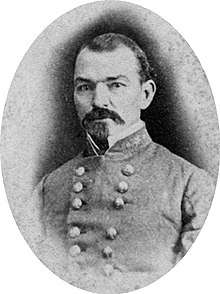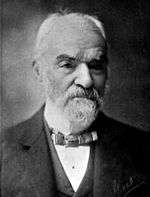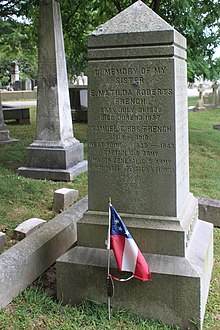Samuel Gibbs French
Samuel Gibbs French (November 22, 1818 – April 20, 1910) was an officer in the U.S. Army, wealthy planter, author, and a major general in the Confederate army during the American Civil War. He commanded a division in the Army of Tennessee in the Western Theater.
Samuel Gibbs French | |
|---|---|
 Samuel Gibbs French | |
| Born | November 22, 1818 Mullica Hill, New Jersey |
| Died | April 20, 1910 (aged 91) Florala, Alabama |
| Place of burial | |
| Allegiance | |
| Service/ | |
| Years of service | 1843–1856 (USA) 1861–1865 (CSA) |
| Rank | |
| Commands held | Divisional Commander of the Army of Tennessee |
| Battles/wars | Mexican–American War American Civil War |
| Other work | Planter and author |
Biography
Samuel G. French was born in Mullica Hill, New Jersey. His larger family lived in both Gloucester and Salem Counties.[1] He graduated from the United States Military Academy in 1843. His classmates included future Civil War generals Ulysses S. Grant, William B. Franklin, Roswell Ripley, and Franklin Gardner. French was brevetted as a second lieutenant in the 3rd U.S. Artillery and assigned to garrison duty.
During his military service in the Mexican–American War, he was wounded at the Battles of Monterrey and Buena Vista. He was awarded a congressional award and a sword from the State of New Jersey and became an original member of the Aztec Club of 1847. He rose to the rank of Captain, but resigned his commission in May 1856 to become a planter in Mississippi.


When the Civil War began, French sided with the South. On February 12, 1861, French was appointed chief of ordnance of the state of Mississippi; and on October 23, 1861, he was appointed a brigadier general in the provisional army of the Confederate States of America. French became a major general on August 31, 1862. General French commanded a brigade and subsequently a division under Gen. Daniel Harvey Hill at Petersburg, Virginia. He led a demonstration against Harrison's Landing on July 4, 1862 and one against Suffolk, Virginia on September 22, 1862. (Fort French at Suffolk was named for him.) In 1863, French led a division under LTG James Longstreet in the Siege of Suffolk. French's division intervened in the Battle of Suffolk (Hill's Point), with its commander waiting for the federals who had seized Fort French to withdraw from their exposed position.
French was transferred to the West. French commanded a division in Jackson, Mississippi during Gen Joseph E. Johnston's effort to relieve the Siege of Vicksburg. Later he served under LTG Leonidas Polk in Mississippi. French served in Polk's corps, later under LTG Alexander P. Stewart, in the Atlanta Campaign of the Army of Tennessee, which was led by Johnston and then by Gen John Bell Hood. On October 5, 1864, after the fall of Atlanta, Hood sent French with his division to break the line of communication of Sherman's army by capturing Allatoona Pass. The pass was held by a federal garrison under Gen. John M. Corse, who defended it in the Battle of Allatoona. When federal reinforcements arrived, General French withdrew his division to New Hope Church and rejoined the Army of Tennessee. French served in the Franklin–Nashville Campaign. Illness forced him to return home in December 1864; but he returned to service in 1865, commanding forces in Mobile, Alabama to the end of the war.
After the war, he returned to his work as a southern planter, and later authored the book "Two Wars" about his war experiences. French had married Mary Fontaine Abercrombie on 12 January 1865. Mary Fontaine Abercrombie died on 16 May 1900 at Atlanta, Georgia. They had two sons and a daughter. Gen French died in Pensacola, Florida in 1910. General French was buried in Florida but a memorial to him was constructed in the Laurel Hill Cemetery in Philadelphia, Pennsylvania.[2]
Legacy and honors
During World War II the Liberty ship SS Samuel G. French was built in Panama City, Florida, and named in his honor.[3]
There is a bust and marker of French in the National Military Park, Vicksburg, Mississippi.[4]
Notes
- Armstrong, Samuel S. "Trenton in the Mexican, Civil, and Spanish–American Wars", accessed May 9, 2007. "Samuel Gibbs French was a native of Salem County, N.J. and graduated from West Point in 1843 with the brevet rank of Second Lieutenant and assigned to the Third U.S. Artillery, July 1, 1843."
- Samuel Gibbs French Find a Grave No. 4532 Retrieved May 9, 2016.
- Williams, Greg H. (25 July 2014). The Liberty Ships of World War II: A Record of the 2,710 Vessels and Their Builders, Operators and Namesakes, with a History of the Jeremiah O’Brien. McFarland. ISBN 1476617546. Retrieved 7 December 2017.
- National Park Service page about Samuel French bust at Vicksburg
References
- Armstrong, Samuel S. "Trenton in the Mexican, Civil, and Spanish–American Wars", accessed May 9, 2007.
- Eicher, John H., and David J. Eicher, Civil War High Commands. Stanford: Stanford University Press, 2001. ISBN 978-0-8047-3641-1.
- Sifakis, Stewart. Who Was Who in the Civil War. New York: Facts On File, 1988. ISBN 978-0-8160-1055-4.
- Warner, Ezra J. Generals in Gray: Lives of the Confederate Commanders. Baton Rouge: Louisiana State University Press, 1959. ISBN 978-0-8071-0823-9.
External links
- Samuel Gibbs French at Find a Grave
- Samuel Gibbs French (1901). Two Wars: an Autobiography of General Samuel G. French ... Confederate veteran.
- History of Salem County by Joseph S. Sickler, pub 1937 pp-243, 276-277
- Works by Samuel Gibbs French at Project Gutenberg